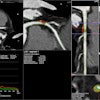Dear Advanced Visualization Insider,
As critical supply shortages in testing equipment and personal protective equipment for healthcare workers emerged during the onset of the COVID-19 pandemic, many 3D printing labs around the world immediately sprang into action to fulfill this urgent need.
A multidisciplinary group from Beth Israel Deaconess Medical Center recently shared its experience assessing and validating 3D-printed nasopharyngeal swabs for use in SARS-CoV-2 testing. After evaluating over 150 different potential swab designs, the team performed a clinical trial for four prototypes. All four passed the test, as you can read about in this issue's Insider Exclusive.
The efforts of 3D printing labs in radiology departments to contribute in the fight against COVID-19 was also the focus of a recent webinar held by the RSNA's 3D Printing Special Interest Group. In several presentations, leaders detailed how their radiology 3D printing labs produced 3D-printed nasopharyngeal swabs, face shield holders, and surgical masks.
In other advanced visualization news, an artificial intelligence (AI) algorithm has shown potential for automatically assessing image quality on 3D whole-heart cardiac images. In testing, the model produced similar results to a human expert. The researchers concluded that the deep-learning framework could be used to compare image volumes from the same acquisition that are reconstructed with different algorithms and to select the image with the best quality.
The image reconstruction process has been deemed a ripe opportunity for the application of deep learning. A multinational team of researchers has raised concerns, however, over the inherent stability of AI for this application. After assessing the performance of six AI-based image reconstruction methods, the group found a number of significant problems that could potentially even lead to a wrong diagnosis.
We also have an interesting case report showing how 3D-reconstructed CT images were utilized to plan the removal of a 3-cm dental needle found in a patient's neck.
Is there a story you'd like to see covered in the Advanced Visualization Community? Please feel free to drop me a line.




















